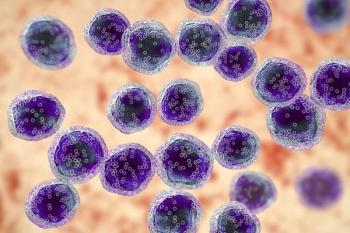
- Oncology Vol 28 No 9
- Volume 28
- Issue 9
Routine Use of Maintenance Therapy in Follicular Lymphoma: The Strategy Is Effective, Raising the Question, ‘What Is the Most Important Measure of Success in the Current Era?’
The rationale for maintenance therapy in indolent non-Hodgkin lymphoma was derived from historical data suggesting that despite robust response rates to standard therapy, most patients eventually relapse and disease-free intervals become progressively shorter.
The rationale for maintenance therapy in indolent non-Hodgkin lymphoma (iNHL) was derived from historical data suggesting that despite robust response rates to standard therapy, most patients eventually relapse and disease-free intervals become progressively shorter.[1] This perception that iNHLs are highly treatable but incurable is a difficult concept for most patients and many clinicians. Goals of therapy focus on maintaining disease control while minimizing lymphoma-related symptoms to maintain quality of life. Given the natural history of iNHLs, the sequence of therapy over an individual’s disease course is likely more important than the impact of a single treatment decision. Therefore, while the gold standard measure of efficacy in iNHL should be overall survival (OS), the benefits of extending disease-free intervals should not be underemphasized, given the rapidly evolving therapies in the post-rituximab (R) era.
Although several management strategies are utilized for patients with treatment-naive follicular lymphoma (FL),[2] R is often incorporated into the regimen when treatment is initiated, because a number of studies have reported improvement in response, progression-free survival (PFS), and OS with R.[3-6] In addition to efficacy, R is associated with an acceptable toxicity profile even when combined with chemotherapy. As a result, extended R dosing (R-maintenance) has been examined, in anticipation of extending disease-free intervals without negatively impacting quality of life. In randomized studies, R-maintenance was associated with significantly prolonged event-free survival, PFS, and time to next therapy in both treatment-naive[7-9] and relapsed/refractory patients[10-14] with FL, compared with observation. Depth of response has been improved,[7,13] and efficacy was demonstrated following R monotherapy,[9,10,12] R combined with chemotherapy,[7,13,14] and chemotherapy.[8,11] Different dosing schedules (eg, one dose every 27 months[9,10,13] or 3 months[11]; 4 weekly doses every 6 months[8,12,14]) and durations (eg, 9 months[10,14], 2 years[7-9,11-13]) have been reported. The breadth of data suggests clinical benefit from R-maintenance even with heterogeneous application. R-maintenance was adopted early in practice and more heterogeneity was observed in utilization without impacting the effectiveness of maintenance,[15] which highlights uncertainties regarding optimal dosing schedule or duration.
An alternative to R-maintenance is R-retreatment. This strategy, first reported in relapsed/refractory iNHL following R monotherapy, was inferior to maintenance in regard to response rates and PFS, but similar results were observed in OS and time to next therapy.[12] Preliminary findings of a randomized study of patients with treatment-naive FL of low tumor burden reported time to treatment failure was no different between maintenance and retreatment following R induction at a median follow-up of less than 4 years, although a significantly higher percentage of patients in the maintenance group remained free of chemotherapy with substantially more exposure to R (15.8 vs 4.5 doses).[16] This highlights one of the key questions that oncologists face: Is there a negative impact with prolonged exposure to R in the absence of disease progression?
In an observational, prospective study with more than 5 years of follow-up, outcomes following second-line therapy were compared for FL patients who completed an R-based induction followed by either R-maintenance or observation.[15] The response rates and PFS following second-line therapy in patients who received R-maintenance were similar to outcomes in patients who were observed. R-maintenance was well tolerated and was infrequently discontinued.
Valid concerns in regard to maintenance therapy include safety, cost-effectiveness, R resistance, and lack of data suggesting an improvement in OS. To achieve the power required to discern a difference in OS in FL, large studies with many years of follow-up will be needed, to ascertain whether R-maintenance can impact OS. In the meantime, effectively delaying the next course of therapy through the use of maintenance may provide a greater impact than increased OS. Given the number of very promising noncytotoxic therapies under investigation, the next management strategy available to previously treated patients with FL may be worth waiting for.
Financial Disclosure:Dr. Nastoupil receives honoraria from Genentech.
References:
1. Johnson PW, Rohatiner AZ, Whelan JS, et al. Patterns of survival in patients with recurrent follicular lymphoma: a 20-year study from a single center. J Clin Oncol. 1995;13:140-7.
2. Friedberg JW, Taylor MD, Cerhan JR, et al. Follicular lymphoma in the United States: first report of the national LymphoCare study. J Clin Oncol. 2009;27:1202-8.
3. Marcus R, Imrie K, Solal-Celigny P, et al. Phase III study of R-CVP compared with cyclophosphamide, vincristine, and prednisone alone in patients with previously untreated advanced follicular lymphoma. J Clin Oncol. 2008;26:4579-86.
4. Salles G, Mounier N, de Guibert S, et al. Rituximab combined with chemotherapy and interferon in follicular lymphoma patients: results of the GELA-GOELAMS FL2000 study. Blood. 2008;112:4824-31.
5. Herold M, Haas A, Srock S, et al. Rituximab added to first-line mitoxantrone, chlorambucil, and prednisolone chemotherapy followed by interferon maintenance prolongs survival in patients with advanced follicular lymphoma: an East German Study Group Hematology and Oncology Study. J Clin Oncol. 2007;25:1986-92.
6. Hiddemann W, Kneba M, Dreyling M, et al. Frontline therapy with rituximab added to the combination of cyclophosphamide, doxorubicin, vincristine, and prednisone (CHOP) significantly improves the outcome for patients with advanced-stage follicular lymphoma compared with therapy with CHOP alone: results of a prospective randomized study of the German Low-Grade Lymphoma Study Group. Blood. 2005;106:3725-32.
7. Salles G, Seymour JF, Offner F, et al. Rituximab maintenance for 2 years in patients with high tumour burden follicular lymphoma responding to rituximab plus chemotherapy (PRIMA): a phase 3, randomised controlled trial. Lancet. 2011;377:42-51.
8. Hochster H, Weller E, Gascoyne RD, et al. Maintenance rituximab after cyclophosphamide, vincristine, and prednisone prolongs progression-free survival in advanced indolent lymphoma: results of the randomized phase III ECOG1496 Study. J Clin Oncol. 2009;27:1607-14.
9. Ardeshna KM, Qian W, Smith P, et al. Rituximab versus a watch-and-wait approach in patients with advanced-stage, asymptomatic, non-bulky follicular lymphoma: an open-label randomised phase 3 trial. Lancet Oncol. 2014;15:424-35.
10. Martinelli G, Schmitz SF, Utiger U, et al. Long-term follow-up of patients with follicular lymphoma receiving single-agent rituximab at two different schedules in trial SAKK 35/98. J Clin Oncol. 2010;28:4480-4.
11. van Oers MH, Van Glabbeke M, Giurgea L, et al. Rituximab maintenance treatment of relapsed/resistant follicular non-Hodgkin's lymphoma: long-term outcome of the EORTC 20981 phase III randomized intergroup study. J Clin Oncol. 2010;28:2853-8.
12. Hainsworth JD, Litchy S, Shaffer DW, et al. Maximizing therapeutic benefit of rituximab: maintenance therapy versus re-treatment at progression in patients with indolent non-Hodgkin's lymphoma-a randomized phase II trial of the Minnie Pearl Cancer Research Network. J Clin Oncol. 2005;23:1088-95.
13. Witzens-Harig M, Foa R, Di Rocco A, et al. Maintenance with rituximab is safe and not associated with severe or uncommon infections in patients with follicular lymphoma: results from the phase IIIb MAXIMA study. Ann Hematol. 2014 May 14. [Epub ahead of print]
14. Forstpointner R, Unterhalt M, Dreyling M, et al. Maintenance therapy with rituximab leads to a significant prolongation of response duration after salvage therapy with a combination of rituximab, fludarabine, cyclophosphamide, and mitoxantrone (R-FCM) in patients with recurring and refractory follicular and mantle cell lymphomas: results of a prospective randomized study of the German Low Grade Lymphoma Study Group (GLSG). Blood. 2006;108:4003-8.
15. Nastoupil LJ, Sinha R, Byrtek M, et al. The use and effectiveness of rituximab maintenance in patients with follicular lymphoma diagnosed between 2004 and 2007 in the United States. Cancer. 2014;120:1830-7.
16. Kahl BS, Hong F, Williams ME, et al. Results of Eastern Cooperative Oncology Group Protocol E4402 (RESORT): a randomized phase III study comparing two different rituximab dosing strategies for low tumor burden follicular lymphoma. Blood. 2011;118:abstr LBA-6.
Articles in this issue
about 11 years ago
Waiting for a Miracleabout 11 years ago
Heterogeneity and Cancerabout 11 years ago
Gastrointestinal Neuroendocrine Tumors: Slow but Steady Progressabout 11 years ago
Neuroendocrine Tumors: Answers-and Questionsabout 11 years ago
An Update on Gastroenteropancreatic Neuroendocrine Tumorsabout 11 years ago
Tumor Heterogeneity Is Fundamental to the Tumor EcosystemNewsletter
Stay up to date on recent advances in the multidisciplinary approach to cancer.



















































































